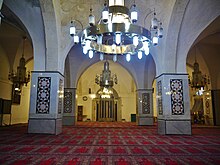
Summary
Al-Jawali Mosque or Amir Sanjar al-Jawli Mosque (Arabic: مسجد الجوالي) is a mosque in Hebron, Palestine, located in the southwestern corner of the Old City and part of the Ibrahimi Mosque (Cave of the Patriarchs) sanctuary.[1]
| Al-Jawali Mosque | |
|---|---|
مسجد الجوالي | |
 | |
| Religion | |
| Affiliation | Islam |
| Branch/tradition | Sunni |
| Location | |
| Location | Hebron, West Bank, Palestine |
 Shown within the West Bank | |
| Geographic coordinates | 31°31′30.000″N 35°6′39.200″E / 31.52500000°N 35.11088889°E |
| Architecture | |
| Type | Mosque |
| Style | Mamluk |
| Groundbreaking | 1318 |
| Completed | 1320 |
| Dome(s) | 1 |
Al-Jawali Mosque was annexed to the Ibrahimi Mosque sanctuary and is an integral part of its layout, bordering the northeastern wall of that structure's enclosure.[1][2] The remaining sides of the al-Jawali Mosque are hewn from stone and the mosque is not visible from the outside.[2] The al-Jawali and Ibrahimi mosques are attached to each other by a passageway running parallel to the latter mosque's prayer hall.[1]
The mosque consists of three arcades with intersecting vaults supported by large stone columns. Each of the arched passageways is covered by a dome.[1] A stone dome with corners decorated by muqarnas design and mosaic windows is situated atop the middle of the prayer hall.[2] The qibla wall's mihrab in the southeastern part of al-Jawali Mosque is carved into the rock of the mosque's walls and tiled with marble slabs decorated with tinted engravings.[1] The mihrab also has a semi-dome which is also decorated with marble.[2]
History edit
Al-Jawali Mosque was built on the orders of the Mamluk Governor of Gaza and Palestine, Sanjar al-Jawli, between 1318 and 1320 during the sultanate of an-Nasir Muhammad. Al-Jawli, for whom the mosque was named, constructed it to enlarge the prayer space to accommodate worshipers using the Ibrahimi Mosque. The mosque was built in an Aleppine architectural design.[1] Fifteenth-century Egyptian historian al-Maqrizi noted that mosque's ceiling was made of "beautifully dressed stone."[3]
According to English churchman Arthur Penrhyn Stanley, the mosque was built on the tomb of Judah, which was destroyed in the process.[4]
References edit
- ^ a b c d e f Dandis, Wala. History of Hebron. 2011-11-07. Retrieved on 2012-03-02.
- ^ a b c d Al-Nathseh, Yusuf. Haram al-Ibrahimi. Discover Islamic Art. Museum With No Frontiers. 2004–2012. Retrieved on 2012-03-02.
- ^ Sharon, 2009, p. 88
- ^ Stanley, Arthur Pnerhyn. Lectures on the history of the Jewish church, Volume 1. J. Murray, 1865. Page 503.
Further reading edit
- Sharon, M. (2009). Corpus Inscriptionum Arabicarum Palaestinae, G. Vol. 4. BRILL. ISBN 978-90-04-17085-8.
- Sharon, M. (2013). Corpus Inscriptionum Arabicarum Palaestinae, H-I. Vol. 5. BRILL. ISBN 978-90-04-25097-0. (Sharon, 2013, p. 105 ff)


